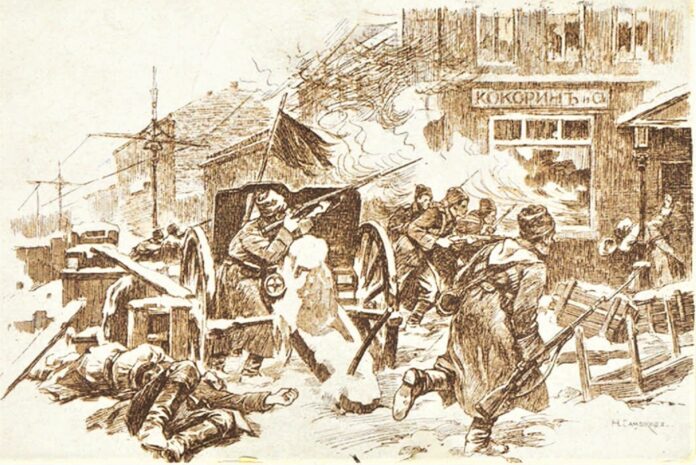
Linkbox i anledning af 100-året for Den Russiske Revolution i 1917. Med 2017-analyser, boganmeldelser og debat – primært fra den anti-stalinistiske venstrefløj. Linkboxen vil løbende blive opdateret. / Updated collections of links with 2017 articles on the 1917 Revolution.
Bjarne A. Frandsen, marts 2017-
_____________________________________________________________________
For supplement, se Den Russiske Revolution, februar-oktober 1917 (Socialistisk Bibliotek/Modkraft Biblioteket, 2007). Linkbox lavet ifm. 90-året for R.R. med ældre og nyere tekster; baggrund og debat om 1917: arbejderrevolution eller statskup + Den Russiske Revolution 1917-1922. / Links compiled for the 90 years of the revolution in 2007, with older and new texts on background and debate on 1917, workers revolution or coup d’etat + the development 1917-1922 (primarily from the anti-Stalinist left).
Indhold / Contents:
- På dansk mv.
- In English
- Bøger / Books
- Se også: / See also
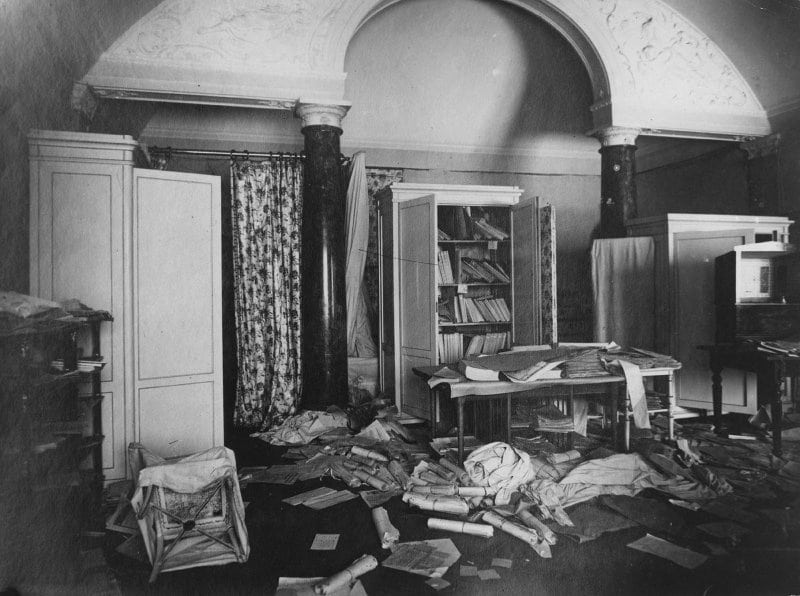
På dansk mv.:
Arbejderen
- Da revolutionen stod for døren i Danmark: Det begyndte i Petrograd. Af Rasmus Ravnholdt Johnsen (24. november 2017). “Den revolutionære bølge, som skyllede ind over Danmark i kølvandet på Oktoberrevolutionen, blev effektivt brudt i løbet af 1920’erne.”
Arbeiderhistorie
- Giv akt! Se revolutionen over verden! (Vol.21, nr.1, 2017). “Arbeiderhistorie 2017 markerer – som seg hør og bør – hundreårsdagen for den russiske revolusjon i 1917, og dens ringvirkninger i Norge.”
Arbejderhistorie
- Oktoberrevolutionen 100 år (nr.2, 2017, 219 s.). Udvidet temanummer i anledning af hundredeåret for den russiske revolution i 1917, “… med en bred vifte af bidrag med forskellige vinkler på sagen”.
Autonom Infoservice
- Tidsdoku. “Lad os føre kampen ind i magtens centrum!” Af Alfred Lang (28. september 2019). “Rusland omkring 1830 under zar Nikolaj 1. var en af de mest brutale monarkier overhovedet … De anarkistiske og marxistiske cirkler i Rusland genspejlede de indbyrdes stridigheder i de vesteuropæiske metropoler og førte til splittelsen af den kæmpende undergrundsbevægelse.”
- Den rådskommunistiske opposition omkring den russiske Oktoberrevolution (14. november 2017). “Den centrale stridspunkt mellem leninisterne og rådskommunisterne var spørgsmålet om autoritet og disciplin i det revolutionære samfund.”
- Oktober 1917 – statskup eller revolution? (10. november 2017). “Den russiske Oktoberrevolution var et folkeligt oprør baseret på krav om ‘Stop for russisk deltagelse i Første Verdenskrig’ og om gennemgribende sociale reformer.”
- Anarkosyndikalisme i Rusland omkring Oktoberrevolutionen (13. oktober 2017). “Anarkosyndikalisternes kamp er ligesom den rådskommunistiske opposition i Oktoberrevolutionen en glemt historie. Det er sejrs herrerne af alle slags, der til alle tider har skrevet historien.” Også online på Konfront.dk: Remember the Anarchists! (17. januar 2019).
Historie-online.dk
- Den russiske revolution 1917: et folks tragiske kamp for frihed. Af Thomas Petersen (29. marts 2017). Anmeldelse af Erik Kulavigs bog (Lindhardt og Ringhof, 2017, 352 s.). Se også anmeldelse af Erik Kulavig: Vi river himlen ned på jorden: drøm og hverdag i revolutionens Rusland 1917-1922 (Lindhardt og Ringhof, 2016, 416 s.) (ibid.).
- Ruslands undergang: revolutioner og sammenbrud 1917-1921. Af Ester Monrad (22. november 2017). Anmeldelse af Bent Jensens bog (Gyldendal, 2017, 529 s.).
Information
100 år efter revolutionen: “100-året for den russiske revolution nærmer sig. Hvad skete der egentlig i revolutionsdagene og årene efter? Var revolutionen en succes eller fiasko? Hvilke følger har den haft for vores måde at tænke på i dag? De spørgsmål besvarer en række forskere og debattører i denne serie”. Se udvalgte artikler:
- Man laver ikke bare en revolution. Af Curt Sørensen (17. oktober 2017). “Historie-skrivningen om Oktoberrevolutionen følger en simpel formel: Først skriver Marx en bog, den læser Lenin, og så laver han en revolution. Fortrængt er det, at revolutionen faktisk var produktet af en af århundredets største folkelige massebevægelser.”
- Oktoberrevolutionen var unødvendig. Af Per Clausen (Information.dk, 22. september 2017). “Da bolsjevikkerne stormede Vinterpaladset, var den sociale revolution i bunden af samfundet allerede gennemført, og revolutionen var reelt overflødig. På længere sigt fik den fatale følger.” Se også Marie Frederiksen: Rosa Luxemburg og den russiske revolution
- Den russiske revolution var en tragedie for socialismen. Af Morten Thing (1. september 2017). “Set i det lange perspektiv har arven fra Oktoberrevolutionen været en tragedie for socialismen som utopisk forestilling om et samfundsalternativ til kapitalismen.”
- Oktoberrevolutionen var de undertryktes festival. Af Hans Jørgen Vad (15. august 2017). “Revolutionen var en eksplosion af socialistisk demokrati. Men da den bredte sig mod vest, blev den bremset. På den måde indvarslede parolen om ’socialisme i ét land’ en regulær kontrarevolution, som fuldbyrdedes i årene efter.”
- ’Friheden er altid kun for dem, der tænker anderledes’. Af Claus Bryld (9. august 2017). “… I samtidens klogeste politiske analyse af den russiske revolution pegede Rosa Luxemburg præcist på de problemer, der efterhånden kom til at underminere og slutteligt ødelægge revolutionen.”
Kritisk Debat
- Rosa Luxemburgs profeti om den russiske revolution (pdf). Af Claus Bryld (16. oktober 2017; online på DBC Webarkiv). “I samtidens klogeste politiske analyse af den russiske revolution pegede Rosa Luxemburg præcist på de problemer, der efterhånden kom til at underminere og sluttelig ødelægge revolutionen og føre til et bureaukratisk, totalitært diktatur.”
- 100 året for den russiske revolution, kvinderne og Lenin (pdf). Af John Graversgaard (16. oktober 2017; online på DBC Webarkiv). “I år er det 100 året for oktoberrevolutionen i Rusland, som på mange måder er værd at fejre … Der er skrevet meget om dette, men lad os se lidt på kvindespørgsmålet. Med inspiration i Tariq Ali’s nyligt udgivne bog: The Dilemmas of Lenin.
Revolution
- Rosa Luxemburg og den russiske revolution. Af Marie Frederiksen
- Fra frigørelse til kriminalisering: Stalinistisk forfølgelse af homoseksuelle fra 1934. Af Fred Weston (31. juli 2018). “I marts 1934 genkriminaliserede Stalin homoseksualitet i hele Sovjetunionen. Fra da af kunne enhver, der var involveret i homoseksuelle aktiviteter blive sat i fængsel i tre til fem år.”
- Bolsjevikkernes afkriminalisering af homoseksualitet – bevidst valg eller et uheld? Af Fred Weston (13. juli 2018). “Oktoberrevolutionen ændrede radikalt på situationen for homoseksuelle i Rusland, på samme måde som den gjorde det for kvinderne.”
- Oktoberrevolutionens resultater. Af Rasmus Jeppesen (7. november 2017). “… det var første gang, at de brede masser – de russiske arbejdere og bønder – tog magten i samfundet, beholdt den og påbegyndte et storslået eksperiment med at transformere samfundet til et højere stadie.”
- Bolsjevikkerne: Ikke kupmagere men bevidste revolutionære. Af Marie Frederiksen (9. oktober 2017). “Modsat hvad der påstås gjorde Lenin og Bolsjevikkerne alt for at sikre, at revolutionen blev så fredelig som mulig.”
- Om Oktoberrevolutionens nødvendighed – svar til Per Clausen. Af Marie Frederiksen (4. oktober 2017). “Hans artikel indeholder en række myter om revolutionen, som ikke adskiller sig nævneværdigt fra dem, man kan finde i en borgerlig kritik af Den Russiske Revolution.”
- Det danske borgerskab og den Russiske revolution. Af Kalle Kühlmann (20. februar 2017). “Denne første del omhandler det danske borgerskab, regeringen og kongehus og deres kamp mod den russiske revolution.” Se også Del 2 (16. april 2017) + Del 3 (18. maj 2017).
- Kvinderne og den russiske revolution. Af Marie Frederiksen (7. marts 2017). “De russiske kvinders deltagelse i revolutionen, Bolsjevikkernes kamp for at organisere dem, og de enorme fremskridt for kvinder, som Oktoberrevolutionen skabte, er en inspiration …”
Rød+Grøn
- Oktoberrevolutionen for historiens domstol. Af Per Bregengaard (nr.95, oktober 2017, s.26-27). “Oktoberrevolutionen i Rusland er en kilde til alvorlige diskussioner i og uden for Enhedslisten. 100-året sætter fut i dem. Revolutionen skal sættes for en historiens domstol.”
Socialisten
- Den russiske revolutions 100 års jubilæum. Del 1 + Del 2. Af Frederik Ohsten (30. januar – 7. februar 2017). “Ligegyldigt om man er tilhænger eller modstander af den russiske Oktoberrevolution, så … ændrede denne begivenhed verdenshistoriens kurs på en hidtil uset måde.”
Socialistisk Arbejderavis
100-året for den russiske revolution:
- Baggrunden. Af Anders Bæk Simonsen (nr.356, 19. januar 2017, s.11).
- Februar-revolutionen. Af Lene Junker (nr.357, 17. februar 2017, s.9).
- Dobbeltmagtsregimet. Af Anders Bæk Simonsen (nr.358, 17. marts 2017).
- Lenins aprilteser. Af Jørn Andersen (nr.359, 1. maj 2017, s.12).
- August: General Kornilovs kup mislykkes – Dobbeltmagts-situationen fortsætter og polariseringen skærpes. Af Lene Junker (nr.360, 27. juni 2017; kun online).
- Februar-revolutionen i Rusland 1917. Af Charlie Lywood (nr.396, 18. oktober 2022, s.3) (Almindelige menneskers historie, del 25). “Den Russiske revolution i 1917 var et afgørende skridt for ideen om, at almindelige arbejdere kunne gennemføre afgørende ændringer i samfundet og træde ind som herskere i stedet for undersåtter. I stedet for at være objekt for historien ( = dvs. passive ofre for historien), blev de til selve historiens subjekt (dvs. den aktivt handlende, der skaber historien). Se del 2 (nr.397, 21. januar 2023) (Almindelige menneskers historie, del 26)
Socialistisk Information
- Hvordan jødiske socialister kæmpede for at standse pogromerne under den russiske borgerkrig (16. juli 2020). “David Broder talte med Brendan McGeever [forfatter til ‘Antisemitism and the Russian Revolution’] om de russiske socialdemokraters historiske modstand mod antisemitismen, om de jødiske socialisters rolle i bekæmpelsen af pogromer under Borgerkrigen …”. Se debat nedenfor på World Socialist Web Site.
- Hvad står der tilbage af Lenin? Af Charlie Jackson (2. maj 2020). “Lenin blev født for 150 år siden. Vi må modstå forsøg på at gøre Lenin til en helgen. Men leninismen tilbyder helt aktuelle og grundlæggende lærdomme om, hvad det vil sige at lave praktisk politik i et kapitalistisk samfund.”
- Sovjetternes strategiske rolle i klassekampen. Af Peter Saxtrup (16. december 2017). “Uafhængigt af, hvad man mener om den russiske revolution og udviklingen i det russiske samfund, der fulgte, så var de selvorganiserede arbejderråd – sovjetterne – et nybrud.”
- Kvindernes rolle i den russiske revolution. Af Jette Kromann (6. december 2017). Artiklen blev holdt som oplæg til debatarrangement den 25. november 2017 om Oktoberrevolutionen, arrangeret af SUF-Århus og Enhedslisten Århus.
- Oktoberrevolutionen og det “national-koloniale spørgsmål”. Af Bill Fletcher (19. november 2017). “… der er et ofte overset kapitel i denne historie, som var af stor betydning for størstedelen af det, vi i dag omtaler som det “globale Syd”, nemlig det national-koloniale spørgsmål.”
- Den russiske revolution 100 år. Af Mikael Hertoft (5. november 2017). “Har vi – nutidens venstrefløj, Enhedslisten, noget til fælles med dem, der ledte revolutionen? Kan nutidens revolutionære lære noget af Lenin? Oplæg om den russiske revolution i Enhedslistens Internationale Udvalg.”
- Kan vi lære noget af den russiske revolution? Af SAPs Forretningsudvalg (31. oktober 2017). “… der er al mulig grund til at bruge hundredeårsdagen til en diskussion af de erfaringer, der blev gjort. Både dem, der bør fejres, og dem, der bør begrædes, så vi kan lære af begge dele..”
- Rusland 1917: Sådan blev scenen sat for en revolution. Af Alan Maass (21. januar 2017). “Den russiske revolution i 1917 er en påmindelse om, at de kampe, der ændrer verden, ofte finder sted der, hvor man ikke forventer det – hvor mulighederne for succes synes mindst gunstige.”
Solidaritet
Sovjetterne er arbejderklassens parlament. Af Peter Saxtrup Nielsen (2. august 2019). “Uanset hvad man mener om den russiske revolution og udviklingen i det russiske samfund, der fulgte, så var de selvorganiserede arbejderråd – sovjetterne – et nybrud.” Oprindeligt bragt i magasinet Solidaritet (nr.13, februar 2018).
Fabriksråd – en ny form for hverdagsmagt. Af Bjarke Friborg (21. juli 2019). “En spontan bevægelse for arbejderkontrol over virksomheder og selvorganiseret produktion var en central del af den russiske revolution. Først nølende, siden med et selvstændigt program for fuld selvforvaltning.” Oprindeligt bragt i magasinet Solidaritet (nr.13, februar 2018).
Temanummer om den russiske revolution (27 s.; tillæg til Solidaritet nr. 13, februar 2018). “Vi lader andre om diskussionen for/mod revolutionen … I stedet forsøger vi at belyse de radikalt nye måder, som folk selv prøvede at organisere familieliv, kunst, arbejde og demokratiske institutioner på.”
Clarté
Hundraåringen som försvann (nr.3, december 2017). “Den ryska revolutionen är den händelse som kanske mer än någon annan bestämde utvecklingen under det förra århundradet … Clarté har följt spåren bakåt i historien. Här är rön från forskningsfronten.”
Gnist: Marxistisk Tidsskrift
1917 (nr.4, 2017). “Det å markere Oktoberrevolusjonen som et rettferdig opprør betyr ikke noen legitimering av det som seinere ble gjort i Sovjetunionen.” Med artikler om bl.a. arbejderbevægelsen i Norge og den russiske revolution, A. Kollontaj + boganmeldelser (Tariq Ali, Neil Faulkner, John Newsinger).
Marxistarkiv.se
- Ryska revolutionen – några lästip. Av Phil Gasper (21. august 2017)
- Den ryska revolutionen 1917 fyller 100 år (24. juli 2017). “På Marxistarkivet uppmärksammar vi 100-årsjubileet med att publicera dokument, artiklar och böcker som belyser olika aspekter av den ryska revolutionen som skakade om en hel värld.”
In English:
Against the Current
- A Russian Civil War chronicle. By Kit Adam Weiner (Issue 217, March-April 2022). Review of Larissa Reisner, The Hammer and the Anvil: Dispatches from the Frontline of the Russian Civil War, 1918-1919 (Bookmarks, 2021, 176 p.). “[The book] brackets 100 pages of Larissa Reisner’s eyewitness reports from the Red Army front from 1918 to 1919, when the author covered the Russian Civil War for Bolshevik newspapers, with essays about Reisner and an excerpt from Trotsky’s autobiography describing the same events.”
- Studying Petrograd in 1917. By Ted McTaggart ( Issue 209, November-December 2020). Review of David Mandel, Petrograd Workers in the Russian Revolution: February 1917-June 1918 (Haymarket Books, 2018, 522 p.). “An expanded, revised edition of two previously published works, this study provides a detailed analysis of the working class of Petrograd not only in their party affiliation but also by profession, neighborhood, gender and nationality.”
- A sympathetic critical study. By Peter Solenberger (Issue 199, March-April 2019). Review of Samuel Farber, Before Stalinism: The Rise and Fall of Soviet Democracy (Verso, 1990 and 2018, 304 p.). “Farber’s argument is controversial among revolutionaries of the Trotskyist tradition and other non-Stalinist revolutionary socialists. Knowing this, and also responding to the August 1991 collapse of the Soviet Union, Against the Current hosted a symposium on Before Stalinism.”
- Thee Soviets and Tsarist debt. By Eric Toussaint (Issue 195, July-August 2018). “The February 1918 repudiation of the Russian Tsarist debt by the new Soviet government shocked international finance and sparked off unanimous condemnation by the governments of the great powers. The struggles that followed are of both historical and present-day interest for nations crushed by international debt.”
- 1917 and the colonial revolution. By Peter Solenberger (Issue 194, May-June 2018). “What was different about 1917 is that the revolution was led by a party whose goal was world revolution. The Bolshevik Party and the government it created were committed to spreading the revolution, not just to the advanced capitalist countries but also to the colonies and semi-colonies.”
- Sex and the Russian Revolution. By Peter Drucker (Issue 193, March-April 2018). “Why does 1917 matter for sexual politics? Because the first decade of the October Revolution yielded an extraordinary wealth of thinking and activism on issues of gender and sexuality.”
- The October Revolution: Its necessity & meaning. By David Mandel (Issue 192, January-February 2018). “I want rather to explain how painfully aware the Bolsheviks … were of the threat of civil war; how much they tried to avoid it, and, failing that, to minimize its severity.”
- Iran: The impact of October. By Yassamine Mather (Issue 191, November-December 2017). “The Russian Revolution had a profound influence on the revolutionary movement in the countries neighboring the new Soviet Republic, and Iran was no exception.”
- The Russian Revolution and workers democracy. By Suzi Weissman (Issue 188, May-June 2017). “The irony (and tragedy) was that the organ of socialist democracy bequeathed to the international working class could not itself survive the aftermath of the Revolution it had been indispensable in bringing about.”
Counterfire
- Category: Revolution Russia 1917
- The Winds of October. By Richard Allday (January 11, 2018). Review of Alan Gibbons’ book (Circaidy Gregory Press, 2017, 230 p.). “A story of young people bringing about the end of a brutal class system during the Russian Revolution.”
- The Russian Revolution – smashing tsarist antisemitism. By John Westmoreland (November 3, 2017). “The revolution that smashed the tsarist state liberated Jews from centuries of oppression.”
- The October Revolution: lessons and legacy (October 26, 2017). “Historian and activist Paul Le Blanc reflects upon the Year One of international working class struggle.”
- Art and politics in revolutionary Russia. Part 1. By Paul Rouhan (April 9, 2017). “This is a radical overview of the art and design of the Russian and Soviet Avant-Garde from 1915 and the decade following the Russian Revolution of 1917.”
- The October Revolution: lessons and legacy (3 March 2017). “Historian and activist Paul Le Blanc reflects upon the Year One of international working class struggle from Counterfire’s recent ‘Revolution: Russia 1917 – on hundred years on’ event.”
- Revolution remembered. By Vladimir Unkovski-Korica (March 3, 2017). “Event commemorating the Russian Revolution, linking it to today’s struggles, was big success for revolutionary left.”
- This is what revolution looks like (February 21, 2017). An excerpt from Louise Bryant’s book Six Red Months in Russia (1918) + the whole book at Marxists Internet Archive. See about Louise Bryant in Socialist Review (Issue 429, November 2017).
- 5 things Orlando Figes got wrong about the Russian Revolution on BBC Newsnight (February 21, 2017). “Orlando Figes was enlisted by the BBC to try and trash the history of the Russian Revolution … Chris Nineham corrects some matters of fact.”
Crisis and Critique
Bolshevik Revolution: One hundred years after (Vol.4, No.2, November 2017, p.5-503). “The present issue of Crisis and Critique brings together some of the most important contemporary thinkers, who engage with the historical, political and philosophical resonances of the Bolshevik Revolution into our context.” With articles, among others, by Alan Badiou, Etienne Balibar, Lars T. Lih and Alan Shandro.
Historical Materialism
- The problems of ‘Political Marxism’ and its application to the ‘Russian Question’. By Mike Haynes (October 2018). A debate between Mike Haynes and John Marot: “I will divide my discussion into two parts: my views on the development of capitalism and the specific problem of Russia.”
- Revisiting the peasant question, the victory of Stalinism, and the problem of alternatives: Reply to Mike Haynes. By John Eric Marot (October 2018). “I will not discuss Political Marxism here because Haynes is unengageable on the topic. Instead, I will try to make sense of Haynes’ extraordinarily discursive critique, in part II of his essay, of my argument regarding the origins of Stalinism.”
- Bolsheviks and Feminists: In cooperation and conflict. By Soma Marik (Blog, 1 December 2017). “Marxist attempts at integrating gender in the class-struggle framework was uneven in the Russian revolutionary movement. A class reductionism often held back the Bolsheviks, but contests with the liberal feminists, as well as the objective reality of more women entering the labour force, led to changes.”
- Did the Bolsheviks advocate socialist revolution in 1917? By Eric Blanc (Blog, 7 October 2017). “In this article, I take a fresh look at Bolshevik stances on state power and socialist revolution from April through October.” See also Paul Le Blanc: Re-Arming the party: Bolsheviks and socialist revolution in 1917 (John Riddell: Marxist Essays and Commentary, October 21, 2017).
- The intelligentsia and the October Revolution. By David Mandel (Blog, 31 August 2017). “But one has to ask if the intelligentsia, by the hostile position it adopted toward the October Revolution, did not itself contribute to this outcome.”
- Before Lenin: Bolshevik theory and practice in February 1917 revisited. By Eric Blair (Blog, 27 February 2017). “Assessing Bolshevik policy before Lenin’s return to Russia in April 1917 has long been one of the most heated historiographic controversies in the socialist movement.”
- A revolutionary line of march: ‘Old Bolshevism’ in early 1917 re-examined. By Eric Blanc (Blog, 31 March 2017). “Through a re-examination of Bolshevik politics in March 1917, the following article demonstrates that the prevailing story is historically inaccurate …”
In Defence of October 1917 (Bolshevik.info)
“A new page dedicated to the Russian Revolution, with videos, reading guides and much more for all those who wish to study the Revolution and the ideas of Bolshevism.”
- Reading Guides (Women and the Russian Revolution + The October Insurrection 1917 + Kornilov’s counterrevolutionary uprising of 1917 + The July Days 1917 + The June Days 1917 + Lenin Returns in April 1917 + The 1917 February Revolution + The Russian Revolution).
- Denmark and the Russian Revolution. By Kalle Kühlmann (10 July 2017). “In Denmark, the revolution resulted in the labour movement splitting into reformists and revolutionaries, and almost turned Denmark into a republic.”
In Defence of Marxism
- Workers’ democracy in the Russian Revolution. Part 1-2 (4-15 February 2019). “[The revolution] is slandered as undemocratic, when in reality it involved the most far-reaching and revolutionary democracy the world has ever seen. In this two-part article, Daniel Morley explains how this worked in practice.”
- The sexual revolution in Russia (2 May 2018). “We publish here in English an oft-quoted text by Dr. Grigory Batkis, published in German in 1925 … this pamphlet outlined the situation in the Soviet Union in relation to family law, women’s and children’s rights, and also explained the impact of the new legislation concerning homosexual relations.”
- Bolshevik decriminalisation of homosexuality – intentional or oversight? By Fred Weston (18 April 2018). “In 1918 all the old Tsarist laws were suspended and when finally, after a few years of debate, the new constitution was adopted, homosexuality or ‘sodomy’ as it was called, was decriminalised.”
- Once again: In defence of Lenin – a reply to Orlando Figes. By Rob Sewell (9 November 2017). “Professor Figes’ A People’s Tragedy of 20 years ago has been republished with a new introduction, in which, among other things, he blames the rise of fascism and the Second World War on Bolshevism …”
- The Russian Revolution: the meaning of October (7 November 2017). “Here we republish an article written in 1992 by Alan Woods, which is an excellent overview of the revolution as well as highlighting its main lessons.”
- Top 10 lies about the Bolshevik Revolution: parts one and two. By Alex Grant (1 November 2017). “No other event in human history has been the subject of more distortions, falsehoods and fabrications the Russian Revolution.”
- ‘The Last of the Tsars’ – a dull, anti-Bolshevik smear. By Ben Gliniecki (3 May 2017). “On the centenary of the Russian Revolution … there are dozens of books and articles to get stuck into. The Last of the Tsars: Nicholas II and the Russian Revolution by Robert Service, is not one of them.”
- Answering fake news about the Russian Revolution. By Rob Sewell (23 February 2017). “A feature appeared recently in the London Evening Standard (10 February, 2017) by a certain Victor Sebestyen about the exhibition Russian Art 1917-1932 at the Royal Academy.”
- What the Russian Revolution achieved and why it degenerated. By Alan Woods (27 January 2017). “… the centenary of the Russian Revolution will inevitably be the occasion for an intensification of the vicious anti-Communist campaign.”
International Socialism
- Out of the shadows: female Leninists and Russian socialism. By Judy Cox (Issue 171, Summer 2021, p.61-82). “This article will not present a comprehensive account of Lenin’s views on female emancipation. Rather, it will explore how the self-activity of working women interacted with an influential network that existed at the heart of the Bolshevik Party.”
- Music, class and party in 1920s Russia. By Mark Abel (Issue 164, Autumn 2019, p.121-147). “The period immediately following 1917 was characterised by an upsurge in artistic experimentation and activity that lasted until nearly the end of the 1920s … Best known are the developments that took place during those years in visual art and literature. But the revolution also had a profound impact on musical life in Russia.”
- The Communist International 100 years on. By Gareth Jenkins and Tony Phillips (Issue 164, Autumn 2019, p.149-170). “This article aims not to give a history of the organisation but to assess some of its achievements and weaknesses.”
- The orphaned revolution: the meaning of October 1917. By Alex Callinicos (Issue 156, Autumn 2017, p.49-72). “… the whole experience of Bolshevism must remain a fundamental reference point for those who seek to continue the revolutionary Marxist tradition.”
- The Russian Revolution and the British working class. By Pete Jackson (Issue 156, Autumn 2017, p.85-114). “This article explores the interplay between the revolutionary events in Russia and the deepening political crisis in Britain.”
- Science, socialism and the Russian Revolution. By John Parrington (Issue 155, Summer 2017, p.97-125). “In this article, I will outline some of the key ways in which both scientific theory and practice blossomed in the years following the revolution, and how these were then affected by the degeneration of the revolution under Stalin.”
- Misrepresenting revolution: Art at the Royal Academy. By Nick Grant (Issue 154, Spring 2017, p.193-207). Review of Revolution: Russian Art 1917–1932, Royal Academy of Arts, Piccadilly, London, 11 February-17 April 2017: “Little is more contested in art history than works from revolutionary Russia.”
International Socialist Review
- Debating the Russian Revolution and its relevance. By Paul Le Blanc (Issue 108, Spring 2018, p.107-124). “I have become a participant in the dispute, occupying a somewhat midway position while rejecting key aspects of the Lars Lih-Eric Blanc reinterpretation of events. Rather than simply repeating my critique of these friends, which can easily be read elsewhere, I will offer some additional thoughts that I am hopeful will help move the discussion forward.”
- Workers’ organizations in the Russian Revolution: Factory committees, trade unions, and the struggle for power. By Amy Muldoon (Issue 107, Winter 2017-18, p.58-86). “Moving in roughly chronological order, the article will look at how the early period of hope and unity across Russian classes foundered on the limits of coalition with the capitalists.”
- Workers’ democracy in revolutionary Petrograd. By Mike Haynes (Issue 106, Fall 2017, p.29-42). “This set of short articles was written as a series, for the UK paper Socialist Worker in the early 1990s … the article draws on the histories of the revolution written in the 1970s and 1980s by what was then a new generation of social historians …”
- An eyewitness to the Russian Revolution. By Mike Haynes (Issue 105, Summer 2017, p.134-143). Review of Alfred Rosmer, Lenin’s Moscow (Haymarket Books, 2016, 275 p.). “Alfred Rosmer’s memoir, Lenin’s Moscow, is one of the most important accounts that we have of the Russian Revolution as its heroic defense began to give way to degeneration in the 1920s … the first French edition was published in 1953.”
Irish Marxist Review
- The Russian Revolution: 100 years on (Vol.6, No.17, 2017, 81 p.). Special Issue: Chronology of the Russian Revolution – The relevance of the Russian Revolution – How the Revolution was won – Alexandra Kollontai, The Russian Revolution and women’s liberation – The Bolsheviks and the sexual revolution – How the Revolution was lost: an interview with Kevin Murphy – Does Leninism lead to Stalinism?
Jacobin: Reason in Revolt
- Socialists should take the right lessons from the Russian Revolution. By Eric Blanc (July 20, 2021). “Socialists have rightly taken inspiration from the Russian Revolution for generations, but many of the lessons drawn from it are wrong for our own time. To make change today, we need to take democratic socialism seriously as a theory and practice.” See reply from Mike Taber: What are the ‘right lessons’ for Socialists? (Marxist Essays and Commentary, August 16, 2021).
- The anti-colonial revolt was key to Lenin’s vision of revolution. By Barnaby Raine (March 1, 2021). “The Russian Revolution enthused anti-colonial movements around the world, fueling hopes that the European empires could be overthrown.”
- The making of the Soviet ruling class. By Kevin Murphy (April 4, 2020). Review of Yuri Slezkine, The House of Government: A Saga of the Russian Revolution (Princeton University Press, 2017, 1128 p.). “[The] portrait of the Soviet elite under Stalin is an eccentric masterwork. But his portrayal of the Bolsheviks as a religious sect is a travesty of history.”
- Women at the heart of the Revolution. By Anne McShane (August 11, 2019). “Alexandra Kollontai and her comrades founded the Zhenotdel in 1918 in order to ensure women’s full participation in Soviet society. Its efforts to liberate women in Muslim Central Asia showed the revolution’s emancipatory promise …”
- Karl Kautsky as architect of the October Revolution. By Lars T. Lih (29 June 2019). “Lenin remained true to the tactical guidelines of Karl Kautsky after the latter had abandoned them.”
- The Russian Revolution reconsidered. By Samuel Farber (25 November 2018). “Between world wars and a crippling civil war, the Russian Revolution fought to change history.”
- Richard Pipes, prosecutor of the Russian Revolution. By Kevin Murphy (12 June 2018). “Relentless anticommunism defined the late Richard Pipes as more propagandist than historian.” See also Sean Guillory: Richard Pipes, the historian as essentialist (ibid., 23 July 2018).
- The revolutionary democracy of 1917. By Soma Marik (27 April 2018). “Those who draw a straight line from the October Revolution to Stalinism invariably ignore the civil war that came in between.”
- The Russian Revolution at 100 (7 November 2017). “We’ve been covering the October Revolution and its aftermath with uncharacteristic nuance: Take a look below at our recent series.”
- History from below. By Neil Davidson (12 January 2018). “Leon Trotsky’s History of the Russian Revolution remains a singular work of Marxist historiography.”
- The golden era. By Suzi Weissman (18 December 2017). “Taking inspiration from both Victor Serge and newer studies, I argue that … between October 1917 and April 1918, the Bolshevik government enacted the most radically democratic platform in history.”
- The few who won. By Bhaskar Sunkara (5 December 2017). “How should we understand the October Revolution and its tragic aftermath?” See debate: Louis Proyect: What can we learn from the Russian Revolution?: a reply to Jacobin (The Unrepentant Marxist, December 20, 2017) + Todd Chretien: Lessons from a road trip down Route 1917 (SocialistWorker.org, December 22, 2017)
- A century after “Ten Days”. By Andrew Hartman (4 December 2017). “John Reed penned the definitive account of the October Revolution — and paid a heavy price for it.”
- From compromise to power. By Kevin Murphy (7 November 2017). “Over the course of 1917, the Petrograd Soviet transformed from a body willing to negotiate with capital to one ready for revolution.”
- How the Bolsheviks won. By Alexander Rabinowitch (7 November 2017). “The Bolsheviks’ rise to power, one hundred years ago today, revisited.”
- The Baku Commune. By Ronald Suny (7 November 2017). “The story of the Baku Commune’s leaders, who pursued power democratically and nonviolently, belies many of the myths of the Russian Revolution.”
- The Kornilov Coup. By Paul Le Blanc (6 September, 2017). “One hundred years ago, why did the alliance between General Lavr Kornilov and Alexander Kerensky fall apart?”
- After the February consensus. By Chris Read (3 September, 2017). “The October Revolution was propelled by mass dissatisfaction with the erosion of February’s gains.”
- The 1917 Peasant Revolutions. By Sarah Badcock (23 August 2017). “In Russia 1917, ordinary rural people took direct action to remake their world.”
- The July Days. By Daniel Gaido (27 July 2017). “The Bolsheviks wanted to avoid the Paris Commune’s fate. That’s why they didn’t take power in July 1917.”
- Violence and Revolution in 1917. By Mike Haynes (17 July 2017). “The revolutionary violence of 1917 paled in comparison to that on the fronts of the Great War.”
- The Women of 1917. By Megan Trudell (24 May 2017). “Women weren’t just the Russian Revolution’s spark, but the motor that drove it forward.”
- Gramsci and the Russian Revolution. By Alvaro Bianchi & Daniela Mussi (25 April 2017)
“What did a young Antonio Gramsci think about the Russian Revolution?” - From February to October. By Lars T. Lih (11 March 2017. “In the standard account, February was the good revolution and October was the extremist one. But events in Russia were far more complex than that.”
- A guide to the February Revolution. By Eric Blanc (8 March 2017). “One hundred years after the February Revolution, we answer your questions about the historic rebellion.”
- The story of the February Revolution. By Kevin Murphy (8 March 2017). “Russian workers went on strike on International Women’s Day 1917. They ended up toppling tsarism.”
- Before February. By Todd Chretien (8 March 2017). “The February Revolution erupted 100 years ago today and swept away a blood-soaked monarchy.”
John Riddell: Marxist Essays and Commentary
- What are the ‘right lessons’ for Socialists? By Mike Taber (August 16, 2021). A reply to Eric Blanc: “His latest article, “Socialists should take the right lessons from the Russian Revolution”, is no exception and merits careful examination … I believe the conclusions Blanc draws are flawed, and that the ‘right lessons’ he points to will lead socialists in the wrong direction.”
- Soviet Russia, Zhenotdel, and women’s emancipation, 1919-1930 (September 29, 2020). “Just how much progress was made in the fight for equality? Anne McShane focuses in particular on Central Asia. See also Part 2 of this study, Zhenotdel: Clubs, Cooperatives, and the Hujum.” This 2017 articles is reposted from Weekly Worker.
- The Bolsheviks in 1917: Index to a Debate (October 12, 2017). “The following are the contributions published so far in an ongoing discussion initiated by Lars Lih and Eric Blanc.”
- Re-Arming the party: Bolsheviks and socialist revolution in 1917. By Paul Le Blanc (October 21, 2017). “A valuable contribution to scholarship on Lenin, the Bolsheviks, and the Russian Revolution of 1917 has – through iconoclastic overstatement – been transformed into an odd and misleading conceptualization by two scholars …”
- Did the Bolsheviks advocate socialist revolution in 1917? By Eric Blanc (October 13, October 2017; also online at Historical Materialism). “In this article, I take a fresh look at Bolshevik stances on state power and socialist revolution from April through October.”
‘All Power to the Soviets! A seven-part series by Lars T. Lih: “In this essay and others to follow later in the spring, I would like to examine the origin of this slogan in its original context of Russia in 1917”:
- Part 1: Biography of a slogan (March 23, 2017)
- Part 2: The proletariat and its ally: The logic of Bolshevik ‘hegemony’ (April 26, 2017)
- Part 3: Letter from Afar, corrections from up close: Censorship or retrofit? (June 24, 2017)
- Part 4: Thirteen to two: Petrograd Bolsheviks debate the April Theses (July 20, 2017)
- Part 5: ‘A basic question’: Lenin glosses the April Theses (August 15, 2017)
- Part 6: The character of the Russian Revolution: Trotsky 1917 vs. Trotsky 1924 (October 25, 2017)
Links: International Journal of Socialist Renewal
- Revolutionary reels: Soviet propaganda film and the Russian Revolution. By Shalon Van Tine (December 6, 2019). “The Bolsheviks focused their film industry on promoting specific communist themes among the Russian people and around the world.”
- Menshevism: The Girondins of 1917. By Doug Enaa Greene (April 25, 2018). “Whatever their differences, Lenin, Plekhanov, Martov, and Trotsky all saw the Russian Revolution as following in the experience of the French Revolution of 1789 … Menshevism was committed to gradualism and opposed to the’“historical impatience’ of a socialist revolution.”
- The Russian Revolutions of 1917. By Paul Le Blanc (August 2017). “Back in the late twentieth century I [wrote this] article on ‘the Russian Revolutions of 1917’ for Encarta Encyclopedia, a digital multimedia encyclopedia published by the Microsoft Corporation from 1993 to 2009.”
- 1917: The view from the streets: Leaflets of the Russian revolution (December 2016 – ). “A series of new translations of revolutionary leaflets and statements being published in commemoration of the 100th anniversary of the Russian Revolution …”
Marxist Left Review
- Russia 1917: gender, class and the Bolsheviks (No.14, Winter 2017). “Sandra Bloodworth looks at the impact of identity politics on some of the best feminist and social historians of the Russian revolution.”
Marxists Internet Archive
Soviet History Archive
See here:
- The 100th Anniversary of the Russian Revolution: Essays and commentary on the most important event of the 20th century in partnership with Jacobin Magazine.
- The October Revolution. “Eye-Witness reports and analyses of the Revolution by its participants and links to historical documents.”
Monthly Review
- Revolution and Counterrevolution, 1917-2017 (Vol.69, No.3, July-August 2017, 126 p.). With articles by John Bellamy Foster, Prabhat Patnaik, Tamás Krausz, Bernard D’Mello, Helena Sheehan, Diana Johnstone, Jean Bricmont and Normand Baillargeon, Edward S. Herman, Samir Amin. See also Louis Proyect: The Western Left and the Russian Revolution: a reply to Diana Johnstone (The Unrepentant Marxist, August 1, 2017) + review of Samir Amin, October 1917: Revolution A Century Later (Daraja Press, 2017, 124 p.).
- One hundred years, one hundred messages. By Tamás Krausz (Vol.69, No.3, July-August 2017, p.27-43). “The October Revolution as an experience of history, remembered as a methodology for the transformation of the world into a community, has persisted far beyond the failed experiment of state socialism itself.”
The Nation
- The Sealed Train. By Sophie Pinkham (June 13, 2017). Review of Catherine Merridale, Lenin on the Train + Sean McMeekin, The Russian Revolution: A New History + S.A. Smith, Russia in Revolution: An Empire in Crisis, 1890-1928. “A century later, historians still disagree about what caused the Russian Revolution.” See also Louis Proyect: Did the Kaiser fund the Bolsheviks? (The Unrepentant Marxist, June 17, 2017) + Boris Souvarine: No, the Kaiser did not fund the Bolsheviks (ibid., July 22, 2017) + Martin Fahlgren: Synpunkter på Catherine Merridales bok Lenins resa till revolutionen 1917 (pdf) (Marxistarkiv.se, 7. august 2017) + review by Willy Cumming (Irish Marxist Review, Vol.8, No.24, p.70-71).
New Politics: A Journal of Socialist Thought
- Herman Axelbank, Max Eastman, and the documentary “Tsar to Lenin”. By Dan La Botz (Blog, November 10, 2017). “In the late 1920s, as the revolution’s red star was fading, a Russian-born man decided to collect as much as possible of the existing film …”
- One hundred years of the Russian Revolution: A retrospective view. By Samuel Farber (Issue 63, Summer 2017, p.10-17). “Thus, the defeat of the Russian Revolution did not only come from hostile outside forces, but also from inside the revolution.”
- The Russian Revolution, Soviets, and socialist democracy (Issue 63, Summer 2017, p.18-26). An interview with Suzi Weissman: author of a biography of Victor Serge, and currently making a movie about Leon Trotsky.
- This changed everything—twice: Russia, revolution, and counter-revolution. By Dan La Botz (Issue 62, Winter 2017). “The Russian Revolution of October 1917 did several things that represented a watershed for the socialist movement.”
- “Glorious Harbinger of a New Society”: The Bolshevik Revolution. By Thomas Harrison (Issue 62, Winter 2017). “The workers’ democracy created by the Bolshevik Revolution did not survive either … For a short time, however, Soviet Russia proved that socialism was a real possibility …” + Part 2: The tragic fate of workers’ Russia (Issue 63, Summer 2017, p.27-43) + Part 3: Stalinism: The complete negation of Socialism (Issue 64, Winter 2018. p.45-56). See also Letters: Russian Revolution (Issue 66, Winter 2019).
RS21: Revolutionary Socialism in the 21st Century
- Queer emancipation in early Soviet Russia. By Ira Roldugina (9 February 2018). “The early Soviet period is marked not only by workers’ power and civil war, but a complete transformation of social life.”
- There is no revolution without love (26 November 2017). “Colin Revolting looks at the film Reds, the story of John Reed and Louise Bryant’s experiences centred on the Russian Revolution, through the lens of relationships and his own passage through the difficult times of the early 1980s.”
- Workers and the Soviet state: lessons from the 1920s (10 November 2017). “Simon Pirani takes a controversial look at changes in relationship between the Communist Party, the state apparatus and the working class in the years between the end of the Civil War and Lenin’s death.”
- Reviewing BBC Radio 4’s coverage of the Russian revolution (29 October 2017). “Martin Crook analyses the presentation of the Russian revolution by the BBC, discussing the various progressive movements that sprang from it while questioning the accuracy of a review that blames the revolution for the sins of Stalinism.”
- After 1917: Civil war and ‘modernising counter-revolution (26 October 2017). “This piece by Gareth Dale sets out to understand how the revolution lost its social basis and political impetus through and after the Civil War. It updates the approach to understanding revolution in general, and the Russian Revolution particularly, that is distinctive to the International Socialist tradition.”
- Harmonies and dissonances: Russia in revolution (28 August 2017). “Mike Haynes illuminates the contested histories of the Russian revolution.”
- Social Histories of 1917 (2 August 2017). “Estelle Cooch, a history teacher in South London, reflects on an unusual series of history lectures that have drawn a new generation into exploring the Russian Revolution.”
- Women in the Revolution (8 March 2017). “Estelle Cooch interviews Katy Turton, author of Forgotten Lives – the role of Lenin’s sisters in the Russian Revolution, 1864-1937 (Palgrave Macmillan, 2007, 257 p.).
- Fidelity to February: The People’s revolution (7 March 2017). “In days where revolution can seem more remote than ever, Dan Swain explores the height of the February revolution and reflects on its relevance to revolutionary politics today.”
- Re-reading Reed: Ten Days that Shook the World (1 March 2017). “Max Leak considers John Reed’s classic book on the Russian revolution.”
- The flight of the young eagles – art of the Russian revolution (16 February 2017). “Tom Michaelson visits the exhibition Revolution: Russian Art 1917-1932 at the Royal Academy.” See also review by by Roger Huddle (Socialist Review, Issue 422, March 2017).
Science & Society
The Russian Revolution one century later (Vol.81, No.4, October 2017). See Contents and Editorial perspectives/Introduction + August H. Nimtz: “The Bolsheviks come to power”: A new interpretation (pdf) (online at Geopoliticaleconomy.org).
Social Histories 1917
“A monthly series of discussion meetings, timed to take place during the run-up to the centenary of Russia’s revolutions of 1917.” See Recordings / past talks.
Socialism Today
- When Britain invaded Soviet Russia (Issue 214, December-January 2017/18). “Within months of the victorious October revolution British forces landed in northern Russia, the start of a counter-revolutionary armed intervention. In an article that first appeared in Militant (No.511, 11 July 1980), Lynn Walsh reviewed Andrew Rothstein, When Britain Invaded Soviet Russia (The Journeyman Press, 1979).
- Women and the Russian revolution. By Heather Rawling (Issue 207, April 2017). “Striking women workers kick-started the February 1917 revolution then, following the Bolshevik-led October revolution, women gained full legal equality with men.”
Socialist Review
- 1919: Britain’s forgotten war on Russia. By Steve Guy (Issue 452, December 2019). “As celebrations commenced at the signing of the General Armistice that ended the First World War, the British army, among others, decided to continue hostilities, this time against the new Soviet Republic of Russia.”
- The Bolsheviks, Islam and the women of the east. By Naima Omar (Issue 433, March 2018). “Many believe that religion and socialism cannot coexist — that in order to be a socialist you have to be an atheist — yet the magnificent example of the Bolsheviks’ relationship with Russia’s Muslim population following the 1917 revolutions is rooted in a different tradition.”
- Antisemitism and the Russian Revolution. By Sabby Sagall (Issue 434, April 2018). “However, a remarkable change developed with the seizure of state power by the Russian working class led by the Bolsheviks in the October 1917 revolution. To begin with, the Bolshevik government abolished all 650 legal restrictions on Jews, establishing a regime of formal equality.”
- From the dream to a nightmare (Issue 431, January 2018). “Patrick Nielsen looks at the circumstances, objective and subjective, which resulted in the revolution being strangled and Stalin coming to dominate — the opposite of the aims of 1917.”
- How does Russia remember its revolution? By Sasha Simic (Issue 430, December 2017). “When a group of us visited St Petersburg and Moscow … we were pleasantly surprised to find lots of exhibitions marking the anniversary and even more gratified to discover that many portray the revolution sympathetically.”
- Music and the Russian Revolution (Issue 430, December 2017). “Sabby Sagall outlines key figures in the movement and looks at debates among revolutionaries about ‘working class culture’.”
- “On the grey horizon of human existence looms a great giant called Working Class Consciousness” (Issue 429, November 2017). “Jan Nielsen tells the story of Louise Bryant, American bohemian, talented journalist and commentator on life in revolutionary Russia.” See also excerpt from Louise Bryant’s book Six Red Months in Russia (1918): This is what revolution looks like (Counterfire, February 21, 2017) + Christine Bird: Six Red Months in Russia: Louise Bryant’s view of the revolution (RS21: Revolutionary Socialism in the 21st Century, November 5, 2017). And the whole book online at Marxists Internet Archive.
- How Russia inspired the world. By Ken Olende (Issue 428, October 2017). “Colonised peoples across the globe celebrated news of the revolution.”
- ‘Women could feel their power’ (Issue 422, March 2017). “Socialist Review spoke to Emma Davis about how women began to take control of their lives and lead in the struggle [in The Russian Revolution].”
- Caught in the Revolution. By Alan Gibson (Socialist Review, Issue 422, March 2017). Review of Helen Rappaport’s book (Windmill Books, 2017, 464 p.). “Helen Rappaport has skilfully woven together the accounts and reports made by more than 80 foreigners who were either visiting or working in Petrograd on International Women’s Day 1917 …”
- ‘From the slow river into a rapid’ (Issue 421, February 2017). “In February 1917 Russian workers toppled the hated emperor, beginning a process of mass revolt … Esme Choonara explains how discontent turned into revolution.”
- Rethinking Revolution. By Sheila McGregor (Issue 421, February 2017). Review of Leo Panitch and Greg Albo (eds.), Rethinking Revolution: Socialist Register 2017 (Merlin Press, 2016). “This collection of essays looks at revolution in the 21st century via the legacy of the Russian Revolution of 1917.”
- 1917: Stories and Poems. By Deila Hutchings (Issue 421, February 2017). Review of Boris Dralyuk (ed.), 1917: Stories and Poems (Pushkin Press, 2016, 240 p.). See interview with Boris Dralyuk: 1917 in their words (Spiked Review of Books, September 2017).
- Democracy for the people, not for the money-bags (Issue 420, January 2017). “The centenary of the Russian Revolution provides an opportunity to re-examine important questions. Sally Campbell argues that a deeply democratic impulse was at the heart of the revolution.”
Socialist Worker
- Category: Russian Revolution centenary
- Hope, Tragedy, Myths—British Library throws the book at the Russian Revolution. By Sarah Bates (Issue 2552, 2 May 2017). “The British Library’s new Russian Revolution exhibition has some fantastic artefacts but a poor conclusion.”
- A hundred years on from the 1917 Russian Revolution – when workers stormed heaven (Issue 2535, 3 January 2017). “A hundred years ago the 1917 Russian Revolution ushered in a radical new society. We start our anniversary coverage with a look at a year that changed the world.”
SocialistWorker.org
- Series: The Russian Revolution
- Series: 1917: The view from the streets. “Read leaflets, statements and other documents from the 1917 Russian Revolution in a series edited by John Riddell.”
- Not a riot but a revolution (November 13, 2017). Elizabeth Terzakis reviews a collection of firsthand accounts of the Russian Revolution of 1917 edited by Todd Chretien: Eyewitnesses the Russian Revolution (Haymarket Books, 2017, 288 p.)
- Editorials: Why we remember 1917 (November 7, 2017). “The promise of the Russian Revolution – its example of mass democracy in action, reaching into every corner of society – hows its relevance for us 100 years later.”
- On the left sat the Bolsheviks (August 8, 2017). Excerpt from a firsthand account of the revolution by socialist journalist Albert Rhys Williams, Through the Russian Revolution (1921). With an introduction by Eric Blanc. And more excerpts: The soldiers in revolt (August 30, 2017) + Comrades of sea (September 27, 2017) + The mighty cry of “All power to the Soviets” (October 31, 2017) + Making a new date in history (November 7, 2017) + The taking of the Winter Palace (November 8, 2017) + The red convicts of Cherm (November 27, 2017).
- How they saw Lenin (May 18, 2017). “Paul Le Blanc surveys accounts and profiles of the Russian revolutionary leader from through the years, in an article based on a planned talk for an upcoming conference in Budapest.”
- Take all power into your hands. Speech by Paul Le Blanc (March 1, 2017). “A historian of the Russian Revolution looks at how revolutionaries put their belief in workers’ self-emancipation into practice.”
- Imaginers of a new future (February 27, 2017). “Amy Muldoon recommends an exhibition of art from the time of the 1917 revolution.”
Solidarity & Workers’ Liberty
Getting Russia wrong: Beevor’s history. By By Paul Vernadsky (Issue 641, 13 July 2022). Review of Anthony Beevor, Russia: Revolution and Civil War, 1917-1921 (Weidenfeld & Nicolson, 2022, 592 p.) “[The book] is perhaps the most miserable account of the Russian revolution published in recent times. It is history-from-above at its worst …”
How the Bolsheviks governed. By Paul Vernadsky (Issue 558, 5 August 2020). “Historian Lara Douds has mined state and party archives in Moscow to produce an excellent book, Inside Lenin’s Government: Ideology, Power and Practice in the Early Soviet State (Bloomsbury, 2018, 240 p.) on how the central apparatus operated.”
Verso, Blog
- Women in Russia before and after the Revolution. Part 1 + Part 2 (7 November 2017). Fist published in 1973: “In this long-read, Sheila Rowbotham examines the changing conditions for women before, during, and after the Russian Revolution, as well as the political and social roles played by women during each period.”
- ‘Weren’t we women first art-iiout on the streets?’: The incomplete history of 1917. By Rochelle Ruthchild (7 November 2017). “The history of 1917 in Russia requires a full range of voices, and attention to the entire spectrum of human emotions and experiences, within the masses as well as the elites.”
- The Octobrist Women. By Tariq Ali (8 March 2017). “Women played a major part in both of the revolutions of 1917, and to a much greater extent than they had in 1905.”
Weekly Worker
- The centrality of hegemony (Issue 1298, May 7, 2020). “150 years after his birth, how to evaluate Lenin and his ideas? Lars T Lih emphasises his consistency.”
- A barometer of progress. By Anne McShane (Issue 1293, April 2, 2020). “NEP had profoundly negative results for the struggle for women’s emancipation.”
- The will to liberate. By Anne McShane (Issue 1233, January 10, 2019). “Neglect of the woman question in the early Soviet republic was not the result of isolation and economic backwardness.”
- Soviet Russia and women’s emancipation (Issue 1181, 30 November 2017). “Just how much progress was made in the fight for equality? Anne McShane focuses in particular on central Asia.”
- Crisis and degeneration. By Rex Dunn (Issue 1161, 29 June 2017). Review of David E Lowes (editor), Arthur Ransome, Three accounts of revolutionary Russia (Red Revenant, 2017, 212 p.). “Arthur Ransome was once [The Guardian] correspondent in Moscow … The book covers the period from late 1919 to early 1921.”
- Witnesses of the revolution. By Rex Dunn (Issue 1160, 22 June 2017). Review of David E Lowes (editor), Bessie Beatty on revolutionary Russia (Red Revenant, 2017, 256 p.). “In 1917, along with Louise Bryant and John Reed, Beatty went to Russia to cover the unfolding revolution … Bessie is not a Marxist, but she is so honest and objective about the drama which is unfolding that she usually comes to the right conclusion!”
- The inferno erupts. By Anne McShane (Issue 1144, 2 March 2017). “The struggle for women’s liberation cannot be left to the feminists. The Russian Revolution shows that women’s liberation and the struggle for socialism are inseparable.”
World Socialist Web Site
- “Literacy is a clean window onto the world …”: 100 years since formation of Soviet Extraordinary Commission for the Liquidation of Illiteracy. By Patrick O’Connor (World Socialist Web Site, 8 July 2020). “The Soviet literacy campaign remains the largest and most successful in world history.”
- Brendan McGeever’s Antisemitism and the Russian Revolution: Distorting history in the service of identity politics. Part 1-2. By Clara Weiss (11-13 April 2020). Review of Brendan McGeever’s book (Cambridge University Press, 2019, 260 p.). “Far from trying to provide an objective account of the origins and role of anti-Semitism in the revolution, McGeever picks and chooses certain facts and events, while leaving out others, to substantiate his claim that ‘antisemitism could find traction within revolutionary politics’.”
See also reviews by Dale Street: Combatting antisemitism within the revolution (Solidarity, Issue 537, 4 March 2020) and John Rose: The Bolsheviks and antisemitism (International Socialism, Issue 168, Autumn 2020) + interview with McGeever: How Jewish socialists fought to stop the pogroms of the Russian Civil War (Jacobin, 2 June 2020). - What the Russian Revolution meant for modern art and culture. By David Walsh (28 February 2018). “Our discussion this evening centers on what this enormous event meant—and continues to mean—for art and culture, which has at least two sides to it: where the revolution and its implications directed or oriented art, as it were, and where modern art actually went.”
- The falsification of David King’s work — Red Star Over Russia: A Revolution in Visual Culture 1905-55 at the Tate Modern in London. By Paul Mitchell (19 December 2017). “… the majority of exhibits are from the unique 250,000-strong collection of photographer, designer and archivist David King.”
- German Historical Museum exhibition presents the October Revolution as an event of world-historical significance. By Verena Nees (6 December 2017). “An exhibition opened October 18 at the German Historical Museum (DHM) in Berlin celebrating the centenary of the October Revolution.”
- How the Bolshevik Revolution saved avant-garde art. By Paul Mitchell (World Socialist Web Site, 30 November 2017). About the exhibition Radical Russia: Art, Culture and Revolution. See also interview with curator Peter Waldron: Radical Russia: ‘The Bolshevik Revolution liberated art and artists’ (Ibid.).
- Russian television’s Trotsky serial: A degraded spectacle of historical falsification and anti-Semitism. By Fred Williams and David North (25 November 2017). “The series is an exhibition of the political, intellectual and cultural depravity of all those involved in the sponsorship and production of this grotesque falsification of history.”
- An artist’s eye view of the Russian Revolution. By Sybille Fuchs (17 November 2017). Review of Katrin Rothe’s animated documentary: 1917: The Real October. “German writer and filmmaker Katrin Rothe’s documentary is an interesting experiment.”
- British Library exhibition treats Russian Revolution from a hostile standpoint. By Thomas Scripps and Paul Mitchell (12 August 2017). “The exhibition’s handling of sources and events transforms the revolution, which proceeded with a political logic well understood by its leaders, into a hodgepodge of accident and happenstance.”
- Professor Sean McMeekin revives discredited anti-Lenin slanders (Part I). By David North (30 June 2017). “McMeekin’s recently published book, The Russian Revolution: A New History (Basic, 2017, 496), … cannot be described as a work of history because McMeekin lacks the necessary level of knowledge, professional competence and respect for facts. McMeekin’s book is simply an exercise in anti-communist propaganda from which no one will learn anything.” See also Part II: Professor Sean McMeekin and the construction of a historical lie (10 July 2017).
- Revolution: New Art for a New World—A careless, unserious treatment of Russian Revolutionary art. By Joanne Laurier and David Walsh (17 March 2017). “British filmmaker Margy Kinmouth is out of her depth in her documentary about Russian avant-garde art.”
- Russian revolutionary art exhibition in London excises Trotsky—and, more generally, historical truth. By Paul Mitchell (25 February 2017). “[The] aim in the Royal Academy’s exhibition is to pour scorn on and discredit the 1917 October Revolution.”
Bøger / Books
Against the Current
Further reading on the Russian Revolution. By Peter Solenberger (Issue 199, March-April 2019)
The Guardian
Top 10 books about the Russian Revolution (12 April 2017). “A century after the Bolsheviks seized power for communism, Tariq Ali chooses some of the best books about an uprising that changed the world forever.” På svensk: De tio bästa böckerna om den ryska revolutionen (pdf) (Marxistarkiv.se, 30. juli 2017).
Haymarket Books
The Russian Revolution at 100. By John McDonald (October 19, 2017). “Below is a listing of what we think are some of most important books — some that we’ve published, others that we wish we published — for today’s activists looking to learn the lessons of the Russian Revolution.”
International Socialism
‘Bookwatch: the Russian Revolution. By Derek Howl (Issue 62, Spring 1994, p.129-146). “The Russian Revolution has generated an enormous literature of varying worth. This article will concentrate upon those books most helpful for socialists.”
International Socialist ReviewThe Russian Revolution: A brief reading guide. By Phil Gasper (Issue 105, Summer 2017, 93-105). “The aim of this very brief review is to make a few suggestions about what to read, mainly for those new to the topic.” På svensk: Ryska revolutionen – några lästip (pdf) (Marxistarkiv.se, 21. august 2017).
New Socialist (UK)
After the end of the World: Re-reading the Russian Revolution. By Owen Hatherley (22 October 2017). “I have in front of me nine books published on the anniversary of 1917 which maintain an undimmed fervour for their side of the argument.”
SocialistWorker.org
Books for Bolsheviks (October 17, 2017). “Todd Chretien provides a readers’ guide to some of the most important books to mark the 100th anniversary of the revolution.”
Verso, Blog
The Russian Revolution: A Verso Reading List (7 November 2017). “One hundred years on from the Russian Revolution we look back at the events that turned the world upside down and how they resonate today with new books from China Miéville and Tariq Ali, and classic texts from the Verso archive, made newly available for the centenary.”
Flohr, Mikkel
Den Russiske Revolution
Redigeret af Mikkel Flohr, Benjamin Ask Popp-Madsen, Kasper Mikael Jacek & Mathias Hein Jessen (Slagmark, 2017, 350 sider). “Bogen indeholder 51 tekster fra Den Russiske Revolution forsynet med korte kontekstualiserende introduktionstekster.” Se Indholdsfortegnelse, Forord og Tidslinje.
- Nybrud i dansk revolutionshistorieskrivning (pdf). Af Curt Sørensen (Arbejderhistorie, nr.1, 2018, s.165-168). Scroll ned.
Foldager, Jonas
Den Russiske Revolution og borgerkrig – da arbejderne tog magten
Af Jonas Foldager og Marie Frederiksen (Forlaget Marx, 2017, 266 s.). “Første halvdel af denne bog er især opbygget omkring Leon Trotskijs “History of the Russian Revolution” [og] andel halvdel … er især bygget op om Victor Serges “Year One of the Russian Revolution.” Se bogens Forord.
- Revolution i Rusland – og dens nederlag. Af Svend Vestergaard Jensen (Socialistisk Information, 17. oktober 2017). “Bogen kan absolut anbefales herfra – og som et nødvendigt bidrag i dette 100-år for den russiske revolution.”
Nygaard, Bertel
1917: Revolution og kontrarevolution i Rusland
Af Bertel Nygaard, Ernest Mandel, Paul Le Blanc og Curt Sørensen (Solidaritet, 2017, 253 s.). “Forlaget Solidaritet en antologi om den russiske revolution, for at give et marxistisk bidrag, og for at imødegå den smædekampagne, forskellige borgerlige historikere kommer med. Hvad gik revolutionen ud på? Hvordan forløb den? Hvilke konklusioner drager vi i dag?”
- Oktober-revolutionen i tale og på skrift. Af Svend Vestergaard Jensen (Socialistisk Information, 30. april 2017). “Forlaget Solidaritet holder reception med Paul le Blanc, en af bidragsyderne til ny antologi om den russiske revolution.”
- Fra Oktober til i dag + Hvad Oktober 1917 kom til at betyde (Socialistisk Information, 13. maj 2017). “Paul Le Blanc introducerer sit bidrag til en ny antologi om den russiske revolution fra forlaget Solidaritet.”
- En politiseret analyse af de russiske revolutioner i 1917 (pdf). Af Kim Frederichsen (Arbejderhistorie, nr. 2, 2017, s.210-212). “Med forlagets politiske-ideologiske profil in mente adskiller denne antologi sig i sin tilgang til emnet således væsentligt fra andre udgivelser, der er udkommet i anledning af 100 års jubilæet …” Scroll ned.
- Se også tidligere bøger fra forlaget:
Paul Le Blanc: Lev Trotskij (Solidaritet, 2016, 286 s.).
Lars T. Lih: Lenin (Solidaritet, 2012, 280 s.).
Ali, Tariq
The Dilemmas of Lenin: Terrorism, War, Empire, Love, Revolution
(Verso, 2017, 384 p.). “This book is not a primer on Lenin. It is a thoughtful and original way of introducing the man and some of his ideas to a new audience in the hostile environment that is the second decade of the 21st century.”
- Lenins dilemmaer. Anmeldelse av Ivar Jørdre (Gnist: Marxistisk Tidsskrift, nr.4, 2017).
- The legacy of Vladimir Lenin (Jacobin: Reason in Revolt, 25 May 2017). An interview with Tariq Ali.
- Tariq Ali asks “Why Lenin” (Verso, Blog, 7 November 2017). Extract from the book.
- Review by Edward Lee-Six (Marx & Philosophy Review of Books, 4 April 2019).
- Trials of the Russian Revolution. Review by Dick J. Reavis (Against the Current, Issue 191, November-December 2017).
- The Lenin behind the distortions. Review by Paul Le Blanc (International Socialist Review, Issue 106, Fall 2017, p.147-158).
- Rescuing Lenin. Review by John Rose (International Socialism, Issue 155, Summer 2017, p.213-217). See Feedback by Noel Halifax: The Bolsheviks and sexual liberation (ibid., Issue 156, Autumn 2017, p.213-217).
- The dilemmas of Lenin. Review by Lindsey German (Counterfire, July 13, 2017).
- The dilemmas of Lenin. Review by Sheila McGregor (Socialist Review, Issue 423, April 2017).
- Review by Andrew Nurse (Left History, Vol.24, No.1, 2021, p.159-161)
Faulkner, Neil
A People’s History of the Russian Revolution
(Pluto Press/Left Book Club, 2017, 272 p.). “In this fast-paced introduction, Neil Faulkner debunks the myths that continue to shroud it, showing how a mass movement of millions, organised in democratic assemblies, mobilised for militant action and destroyed a regime of landlords, profiteers and warmongers.”
- Anmeldelse av Mathias Bismo (Gnist: Marxistisk Tidsskrift, nr.4, 2017).
- Whose revolution? Neil Faulker on the centenary of the October 1917 revolution (Pluto Press, Blog, February 22, 2017).
- A People’s History of the Russian Revolution. Review by Chris James Newlove (Marx & Philosophy Review of Books, 8 June 2018)
- 1917: A change in the soul as much as in the factory. Review by Paul Le Blanc (International Socialist Review, Issue 105, Summer 2017, p.128-133).
- The Russian Revolution: tragedy or inspiration? Review by James Eaden (International Socialism, Issue 155, Summer 2017, p.87-95).
- A People’s History of the Russian Revolution. Review by Alan Gibson (Socialist Review, Issue 425, June 2017).
- Lenin and the Bolsheviks. By Neil Faulkner (Mutiny, 7 August 2020; online at Internet Archive).
Le Blanc, Paul
October Song: Bolshevik Triumph, Communist Tragedy, 1917-1924
(Haymarket Books, 2017, 504 p.). “A panoramic account of the Russian Revolution of 1917 and its aftermath animated by the lives, ideas and experiences of workers, peasants, intellectuals, artists, and revolutionaries of diverse persuasions.”
- Review by Vaios Triantafyllou (Socialist Review, Issue 443, February 2019)
- Paul Le Blanc’s ‘October Song’: Criticism and response (Marxist Essays and Commentary, January 8, 2019)
- Triumph and tragedy. Review by William Smaldone (Against the Current, Issue 197, November-December 2018)
- ‘October Song’ – A challenging portrayal of the Russian Revolution. Review by John Riddell (Marxist Essays and Commentary, October 9, 2018).
- October Song. Review by Lindsey German (Counterfire, September 20, 2018).
- Thinking Bolsheviks. Review by Pepijn Brandon (International Socialist Review, Issue 110, Fall 2018).
- Mining each vein of a rich history. Review by Michael Löwy (SocialistWorker.org, August 20, 2018).
Leplat, Fred
October 1917: Workers in Power
Edited by Fred Leplat and Alex de Jong (Merlin Press, 2016, 234 p.). With articles by Paul Le Blanc, Ernest Mandel, David Mandel, Leon Trotsky, Rosa Luxemburg and Lenin: “[The book] does a magnificent job with its scholarly, primary sources, bibliography, time-line and a glossary to help for those curious about socialism and seasoned activists to reassess and redeem the meaning of the Bolshevik Revolution.” See Contents.
- 1917 was a revolution, not a coup. Review by Paul Hampton (Solidarity & Workers’ Liberty, Issue 449, 4 October, 2017).
- The Russian Revolution. Review by Peter Solenberger (Against the Current, Issue 189, July-August 2017).
- October 1917. Review by Judy Cox (Counterfire, June 22, 2017).
- October 1917. Review by Ian Taylor (Socialist Review, Issue 422, March 2017).
- Redeeming the revolution. Review Doug Enaa Greene (International Viewpoint, 24 January 2017).
Mieville, China
October: The Story of the Russian Revolution
(Verso, 2017, 358 p.). “In a panoramic sweep, stretching from St Petersburg and Moscow to the remotest villages of a sprawling empire, Miéville uncovers the catastrophes, intrigues and inspirations of 1917, in all their passion, drama and strangeness.”
- October and its relevance: Eric Blanc talks with China Miéville (Historical Materialism, Blog, 11 July 2017) + excerpt from the book: Epilogue to a Revolution (Jacobin: Reason in Revolt, 5 July 2017). På svensk: Epilog till en revolution (pdf) (Tidsignal, nr.15, 2017; online på Marxistarkiv.se) + another excerpt: The day that shook the world (Jacobin, 7 November 2017).
- A novel retelling of the October Revolution (International Socialist Review, Issue 107, Winter 2017-18, p.46-57). China Miéville interviewed by Todd Chretien.
- There’s nothing so weird as a revolution. Review by Ian Birchall (RS21: Revolutionary Socialism in the 21st Century, December 17, 2017)
- Power to the Soviets. Review by David Cohen (Against the Current, Issue 191, November-December 2017).
- The unfinished revolution. Review by Esme Choonara (International Socialism, Issue 156, Autumn 2017, p.221-223).
- Revolutionary possibility. Review by Henry Farrell (Jacobin: Reason in Revolt, 25 September 2017).
- Raising the red lantern. Review by Todd Chretien (SocialistWorker.org, September 18, 2017).
- October 1917: a noble, ambitious revolution. Review by Michael Fitzpatrick (Spiked Review of Books, September 2017).
- China Miéville’s October. Review by Charlie Burton (RS21: Revolutionary Socialism in the 21st Century, August 8, 2017).
- October. Review by Richard Rose (Socialist Review, Issue 425, June 2017).
- 1917: A change in the soul as much as in the factory. Review by Paul Le Blanc (International Socialist Review, Issue 105, Summer 2017).
- October by China Mieville. Review by Jane Shallice (Socialist Resistance, May 25, 2017).
- What’s Left? Review by Sheila Fitzpatrick (London Review of Books, Vol.39, No.7, 30 March 2017). På svensk: Vad blev det kvar? (pdf) (Marxistarkiv.se, 8. september 2017).
Molyneux, John
Lenin for Today
(Bookmarks, 2017, 288 p.). “Molyneux’s book is an accessible starting point for those who want to understand Lenin’s ideas and their importance in fighting to change the world.”
- Lenin for today. Review by Paul Le Blanc (Links: International Journal for Socialist Renewal, March 27, 2018).
- Lenin for today. Review by Tomas Tengely-Evans (Socialist Review, Issue 426, July-August 2017). See also letter by John Molyneux: Lenin for Today has lots to offer readers (ibid., Issue 427, September 2017).
- Lenin for today. Review by Barney Doherty (Irish Marxist Review, Vol.6, No.18, 2017, p.84-86).
- Does Leninism lead to Stalinism? (John Molyneux Blog, May 5, 2017). Chapter 6 from the book.
Newsinger, John
1917: Russia’s Red Year
By John Newsinger and Tim Sanders (Bookmarks, 2016, 100 p.). “This graphic novel is an accessible introduction to Russia’s ‘red year’ and contributes to an important interpretation of the events.”
- Anmeldelse av Jonas Bodin Granerud (Gnist: Marxistisk Tidsskrift, nr.4, 2017).
- Russian Revolution in pictures. By Sally Campbell (Socialist Review, Issue 418, November 2016). Interview with Tim Sanders and John Newsinger.
- Russia’s red year. Review by Siobhan Brown (Socialist Review, Issue 419, December 2016).
- 1917 – Russia’s Red Year is inspiring in full colour a century on. Review by Gabby Thorpe (Socialist Worker, Issue 2531, 22 November 2016).
Rabinowitch, Alexander
The Bolsheviks Come to Power: The Revolution of 1917 in Petrograd
(Haymarket Books, 2017, 400 p.; new edition). “[The book is] bringing all the excitement and complexity of one of the most important chapters in the struggle for socialism into full, living color.” See also Rabinowitch, The Bolsheviks in Power: The first Year of Soviet Rule in Petrograd (Indiana University Press, 2007, 494 p.).
- How the Bolsheviks won. By Alexander Rabinowitch (Jacobin: Reason in Revolt, 7 November 2017). “The Bolsheviks’ rise to power, one hundred years ago today, revisited.”
- ‘The October Revolution was the most important event of the 20th century’. By Wolfgang Weber (World Socialist Web Site, 1 June 2011). Interview with Alexander Rabinowitch.
- Undoing the rigid stereotypes of the Russian Revolution. Review by Haley Pessin (International Socialist Review, Issue 106, Fall 2017, p.139-146).
- The Bolsheviks come to power. Review by Chris Nineham (Counterfire, September 28, 2017).
- Leadership battles. Review by Megan Trudell (International Socialism, Issue 107, Summer 2005).
- The crisis of revolutionary power. Review by Sarah Badcock (Against the Current, Issue 140, May-June 2009).
- Lenin’s Petrograd. Review by Ken Olende (International Socialism, Issue 117, Winter 2008).
- The Bolsheviks in power. Review by Chris Bambery (Socialist Review, Issue 318, October 2007).
- Bolsheviks in Power: Professor Alexander Rabinowitch’s important study of the first year of soviet power. Review by Frederick Choate and David North (World Socialist Web Site, 9 November 2007).
Sherry, Dave
Russia 1917: Workers’ Revolution and the Festival of the Oppressed
(Bookmarks, 2017, 279 p.). “This is an impressive account which aims to set the record straight about how the revolution came about, and the reasons behind its ultimate downfall.”
- ‘Revolution is much more prevalent than our rulers would have us believe’ (Socialist Review, Issue 425, June 2017). Interview with Dave Sherry.
- How far was the Russian Revolution made by the Bolsheviks? Review by Steve Smith (International Socialism, Issue 156, Autumn 2017, p.219-221).
- Russia 1917. Review by Paul O’Brien (Irish Marxist Review, Vol.6, No.18, 2017, p.87-89).
- Russia 1917. Review by Colette Wyme (Socialist Review, Issue 424, May 2017).
- Russia 1917 — new book is a weapon against the right. Review by Martin Empson (Socialist Worker, Issue 2552, 2 May 2017).
Smith, S.A.
Russia in Revolution: An Empire in Crisis, 1890 to 1928
(Oxford University Press, 2017, 455 p.). “There are also accumulating contributions by established academics, definitely not Bolshevik partisans, reaching for an objective account and scholarly evaluation of what happened. Steven A. Smith has written one of the best of these.”
- The Russian Revolution reconsidered. Review by Samuel Farber (Jacobin, 25 November 2018).
- Trials of the Russian Revolution. Review by Dick J. Reavis (Against the Current, Issue 191, November-December 2017).
- Seeing all the faces of the Russian Revolution. Review by Paul Le Blanc (SocialistWorker.org, July 20, 2017).
- The Russian Revolution: tragedy or inspiration? Review by James Eaden (International Socialism, Issue 155, Summer 2017, p.87-95).
- Russia in Revolution. Review by Tony Phillips (Socialist Review, Issue 425, June 2017).
- What’s Left? Review by Sheila Fitzpatrick (London Review of Books, Vol.39, No.7, 30 March 2017). På svensk: Vad blev det kvar? (pdf) (Marxistarkiv.se, 8. september 2017).
Vernadsky, Paul
The Russian Revolution: When Workers took Power
(Phoenix Press/Workers’ Liberty, 2017, 374 p.). “The book includes a narrative of the revolution, a study of the Bolsheviks who organised and led the revolution, debates about issues raised in and after the revolution, and an unflinching examination of “what went wrong” and how and why the revolution was usurped by Stalinism.”
- The opening days of the Russian Revolution (Workers’ Liberty, 15 February 2017). “This extract from Paul Vernadsky’s forthcoming book on the revolution describes the background and opening events” + another extract from the book: The October revolution: taking power and holding on (ibid., 18 October 2017).
- Trials of the Russian Revolution. Review by Dick J. Reavis (Against the Current, Issue 191, November-December 2017).
- Russian lessons for today’s workers. Review by Vicky Morris (Solidarity & Workers’ Liberty, Issue 436, 26 April 2017).
- 1917 and problems of democracy. Review by Andrew Coates (Solidarity & Workers’ Liberty, Issue 447, 6 September 2017). See reply from Paul Vernadsky: Remember the opposition to Stalin (ibid.).
- Kautsky and ideas ‘from outside’. By Colin Waugh (Solidarity & Workers’ Liberty, Issue 449, 4 October 2017). See reply from Paul Vernadsky: Not all wisdom in the workplace (ibid., Issue 450, 11 October 2017)
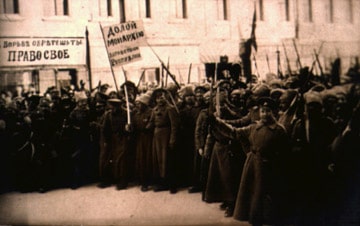
Se også: / See also:
- Linkbox om Den sorte bog om ’kommunismens’ forbrydelser. Debat om Stéphane Courtois m.fl.’s bog.
- Linkbox om Lars T. Lihs Lenin-biografi.
- Linkbox om John Reed (1887-1920).
- Linkbox om Victor Serge (1890-1947).
- Linkbox om Kronstadt 1921.
- Linkbox om Kommunistisk Internationale (Komintern) 1919-1943.
- Linkbox om Berlinmurens fald. Om Berlinmurens fald i 1989 og stalinismens sammenbrud i Østeuropa/USSR.
- Tidslinjen 20. juli 1953 om storstrejke i den sovjetiske fangelejr i Vorkuta.
- Tidslinjen 5. marts 1953 om Josef Stalin (1878-1953).
- Tidslinjen 21. august 1940 om mordet på Trotskij.
- Tidslinjen 15. marts 1938 om Nikolaj Bukharin (1888-1938).
- Tidslinjen 19.-24. august 1936 om Moskvaprocesserne.
- Tidslinjen 18. juni 1935 om Trotskijs ophold i Norge.
- Tidslinjen 1934 om Nestor Makhno (1888-1934).
- Tidslinjen 27. november 1932 om Trotskijs Københavnerbesøg.
- Tidslinjen 21. december 1925 om Sergej Eisenstein (1898-1948).
- Tidslinjen 15. oktober 1923 om Venstreoppositionen.
- Tidslinjen 8. marts 1921 om ny økonomisk politik (NEP).
- Tidslinjen juni 1920 om Lenins “Venstrekommunismen – en børnesygdom”.
- Tidslinjen august-september 1917 om Lenins “Staten og revolutionen”.
- Tidslinjen 17. april 1917 om Lenins “April-teser”.
- Tidslinjen 8. marts 1917 om Februar-revolutionen.
- Tidslinjen januar-juni 1916 om Lenins “Imperialismen som kapitalismens højeste stadium”.
- Tidslinjen august-september 1910 om Lenins Københavnerbesøg.
- Tidslinjen september 1906 om Trotskij og den permanente revolution.
- Tidslinjen 9. januar 1905 om “Den blodige søndag”.
- Tidslinjen marts 1902 om Lenins “Hvad må der gøres”.
- Tidslinjen 23. september 1883 om Grigorij Zinovjev (1883-1936).
- Tidslinjen 7. november 1879 om Lev Trotskij (1879-1940).
- Tidslinjen 31. marts 1872 om Alexandra Kollontaj (1872-1952).
- Tidslinjen 22. april 1870 om Lenin (Vladimir Iljitj Uljanov) (1870-1924).
- Tidslinjen 11. december 1856 om Georgij Plekhanov (1856-1918).


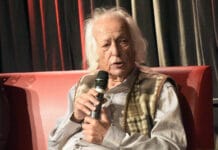

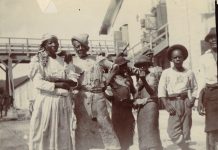
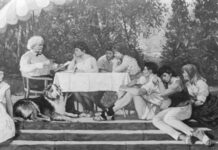


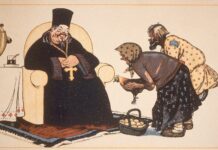
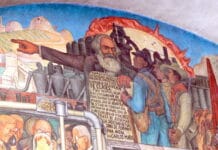









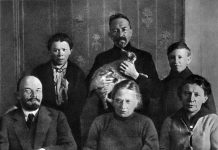

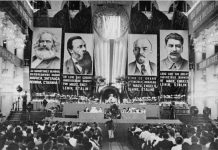












![A demonstration of workers from the Putilov plant in Petrograd (modern day St. Peterburg), Russia, during the February Revolution. The left banner reads (misspelt) "Feed [plural imperative] the children of the defenders of the motherland"; the right banner, "Increase payments to the soldiers' families - defenders of freedom and world peace". Both refer to the economic toll the First World War was having on civilian life, February 1917 (probably around March 7 [O.S. February 22]) Photo: Unknown. Public Domain.](https://socbib.dk/wp-content/uploads/2007/04/1917-februarrevolution2.1500x0-100x70.jpg)